Major Grants and Awards
The Department of History has a strong record of research success. Since September 2001, History faculty have been awarded approximately 25 percent of all Social Sciences and Humanities Research Council (SSHRC) Standard Research Grants on campus, and 70 percent of those awarded to faculty in the Humanities and Fine Arts Division of the College of Arts and Science. The department maintains a strong research output and boasts a prestigious research chair in the History of Medicine.
Major Research Grants Received Since 2012
Social Sciences and Humanities Research Council, Insight Grant. 2024-2028,“ $159,459
In 1773 Santiago de los Caballeros, the capital of Spanish Central America, was at the epicentre of a major earthquake. Following the quake, the Spanish government ordered the capital to be moved to the nearby Valle de Las Vacas. Many of the residents of Santiago de los Caballeros and the surrounding Panchoy Valley were ordered to move to the new capital. Santiago, now La Antigua Guatemala, was left in ruins by governing officials and mostly ignored in historical research for the next century, But neither the town nor the valley were abandoned and for the next hundred years the old elite in Santiago contested for power with Guatemala City forces while the fertile Panchoy Valley became the centre for agricultural exports and innovation. Maya in surrounding towns, many previously held in encomienda, continued to provide the required labour.
This research uses archival sources in Spain, Guatemala City, and the Department of Sacatepéquez to reconstruct this mostly ignored century of life in the ruins, focusing on the mechanisms used by elite in the town and valley to control land, get access to capital and labour through multiple transitions.
Peace (PI) and E. Dunsworth, (Co-I), L. Madokoro, (Co-I), Andrew Watson (Co-I),
and S. Wilmshurst (Co-I). Social Science and Humanities Research Council of Canada, Connection Grant. 2024, $17,000.
Andrew Watson (PI) and MacFadyen, J (Co-A). Social Science and Humanities Research Council of Canada, Insight Development Grant. “Assembling a City: Toronto’s Urban Metabolism, 1850-1937” (2024). $59,992
Kristina Bidwell (USask) (PI), Cheryl Troupe (USask) (Co-I), Jenna Hunnef (USask)
(Co-I), Rochelle Cote (Memorial University) (Co-I), Michaela Doucette (Memorial University)
(Co-I), Michelle Porter (Memorial University) (Co-I), Andrea Proctor, (Memorial University)
(Co-I). Community Partners: Saskatchewan Anskohk Writer’s Circle, Inc., Gabriel Dumont
Local #11 (Saskatoon), Gabriel Dumont Institute (Saskatoon) and First Light, Research & Strategic Partnerships (St. John’s). ““We’re Still Here”: Amplifying Urban Indigenous Stories in Saskatoon and St. John’s through Indigenous-led Partnerships.” Social Sciences and Humanities Research Council, Reconciliation Network in Response to Call to Action 65. (2024-2028). $1,000,000.
Social Sciences and Humanities Research Council of Canada, Connections Grant. $21,200.
Social Sciences and Humanities Research Council, Insight Grant, 2022-2025; Department of National Defence Research Initiative, Research Grant, 2023-2026
SSHRC Insight Grant, 2022, “Taking Care of Captives: moral decision making, military virtue, and the welfare of prisoners in Eighteenth century warfare,” $110,008.
Department of National Defence Research Initiative, 2022, “Taking Care of Captives: moral decision making, military virtue, and the welfare of prisoners in Eighteenth century warfare,” $60,000.
Collaborating with Sabine Jesner (Historian, Heeresgeschichtliches Museum | Militärhistorisches Institut, Vienna) and Caleb Karges (Concordia University Irvine)
The project seeks comparable elements behind, and motivations for, the treatment of defenseless combatants by their overpowering captors during major European wars from 1700 to 1750. This project adds important layers of historical complexity to contemporary discussions of moral decision making during military operations. This research has significant implications for understanding the factors that foster human welfare even in challenging situations of extreme suffering and destruction, which warfare exhibits in all times and places.
Social Sciences and Humanities Research Council, Partnership Development Grants. 2022-2024,“ $199,952
Collaborating with Susan Brown (PI, U of Guelph), Constance Crompton, Camille Callison, Clare Appavoo, Dean Seeman, Emmanuel Chateau Dutier, James MacGregor, John Aspler, Jon Bath, Kim Martin, Lisa Goddard, Marcello Vitali Rosati, Michael Eberle-Sinatra, Sharon Farnel, Stacy Allison-Cassin, William Turkel, et al.
Forward Linking, a pilot project to transform how cultural materials are shared online, building on the work of the LINKS CFI project that created the digital infrastructure for scholarly linked open data in the humanities.
Galleries, libraries, archives and museums collect many digital cultural resources, such as digitized manuscripts, oral history archives, virtual reality experiences, digital art collections and learning tools. However, these materials are stored on websites that are often isolated from each other and from scholarly contexts.
Under the Forward Linking partnership, experts in culture and heritage, digital scholarship and information science will explore ways of interlinking digital cultural resources across organizations sustainably and equitably. The project will make it easier for people to find, use and benefit from the information.
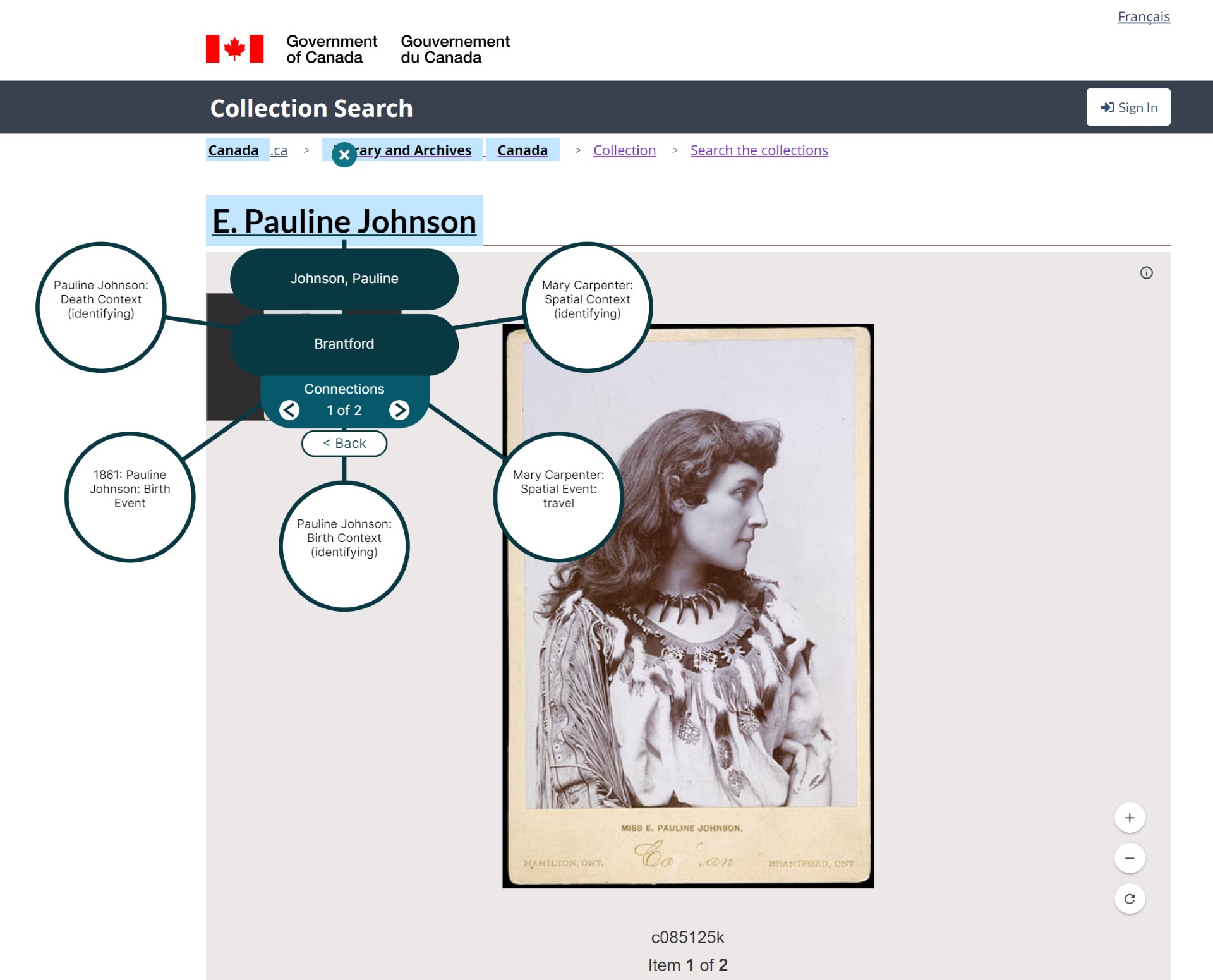
Social Sciences and Humanities Research Council, Insight Grant. 2022-2027,“ $223,000.00
Despite popular representations of witches, real female magic practitioners, commonly known as cunning women, were rarely accused of witchcraft. In fact, such practitioners were commonly understood as protections from witchcraft, and if scholarly estimates are correct, hundreds of thousands offered their magic services at any given time in pre-modern Europe.
Yet in comparison to the hundreds of monographs on the witch trials, not a single credible academic book deals with the female magic practitioner of pre-modern Europe. In addition, while a good deal is known about the unusual hot spots of the witch trials, such as South-Western Germany where the overwhelming majority of the executions took place, very little is known about the regulation of magic practice in most of Europe where such trials and executions were rare or non-existent.
Klaassen and Wright’s research seeks to correct this situation with a close study of late medieval ecclesiastical courts in England, focussed studies of known female practitioners, and a broad-based comparative survey of female practitioners in Western and Central Europe.
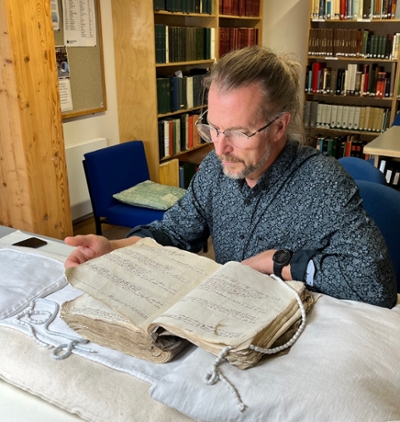
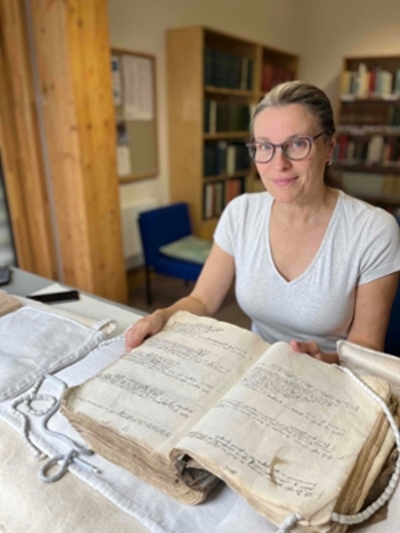
Social Sciences and Humanities Research Council, Insight Grant, 2022-2025; Department of National Defence Research Initiative, Research Grant, 2023-2026
Collaborating with Sabine Jesner (Karl-Franzens Universität Graz) and Caleb Karges (Concordia University Irvine)
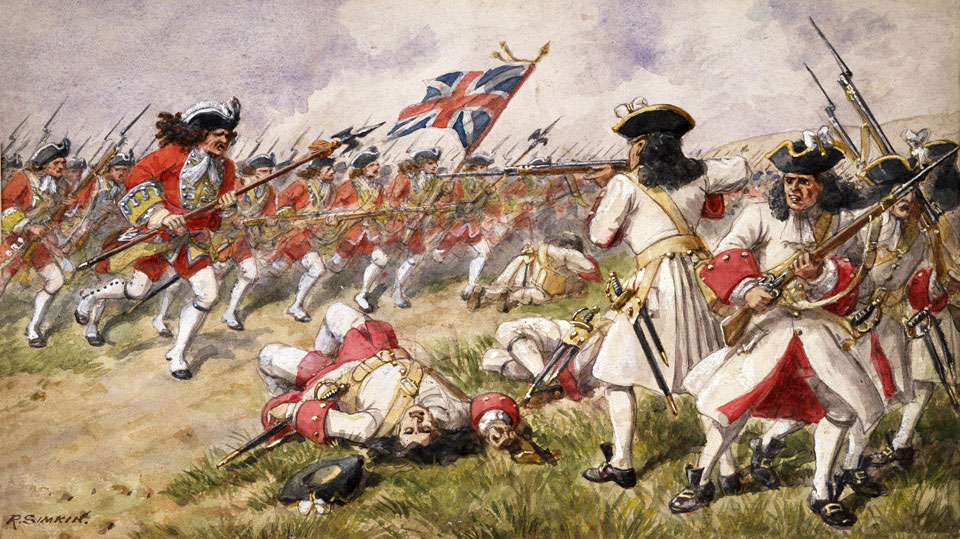
Warfare and its peculiar mechanisms are part of the human behavioural repertory and undeniable facts of history. The Taking Care of Captives project seeks to address the societal challenge of determining what factors foster moral conduct in war by examining the nexus of warfare and welfare in eighteenth-century Europe. From where comes the conviction that the actions of combatants should be constrained by respect and reverence for others, including their adversaries? What factors foster the capacity by soldiers to care about the welfare of prisoners of war? The project also tests the hypothesis that the period saw greater mutual regard and humane treatment in warfare, including toward captured adversaries, which contributed to later conventions on the conduct of war (Geneva 1864 and 1906; Hague 1907).
The project seeks comparable elements behind, and motivations for, the treatment of defenseless combatants by their overpowering captors during major European wars from 1700 to 1750. This project adds important layers of historical complexity to contemporary discussions of moral decision making during military operations. This research has important implications for understanding the factors that foster human welfare even in challenging situations of extreme suffering and destruction, which warfare exhibits in all times and places.
We will demonstrate how historical narrative provides resources for moral decision making because it presumes the salience of both enduring human capacities and contingent social-cultural contexts in any situation demanding ethical judgement. Historical narratives concerning past treatment of powerless adversaries during warfare can support character-based moral formation. The Taking Care of Captives project will provide narrative context for moral decision making in pluralistic and complex combat situations, thereby contributing to character-based moral education, and fostering military virtue.
Social Sciences and Humanities Research Council, Partnership Grant, 2022-2025
Collaborating with Zoe LeBlanc (University of Illinois at Urbana-Champagne), Heidi Tworek (UBC), Cindy Ewing (U of T), UNESCO Library and Archives, and Resonator Inc.

NANReP’s goal is to analyze the formation, structure, operations, experiences, impacts, and legacies of NANAP as an international cooperative of news agencies predominantly from the Third World. In the process, NANReP seeks to shed new light on challenges surrounding systemic barriers in global news-making, the racial realities of international information networks, and anti-racist efforts to change media infrastructures in ways that amplify the voices and stories of marginalized peoples at home and abroad.
Research Junction – 2022-2024
This project brings together academic, City of Saskatoon and Métis community partners to better understand Métis presence and place-making in the city. It uses community-engaged Indigenous research methods, oral history and HGIS methods to document and map Métis place-based stories and histories in the city, providing nuance to urban Métis experiences from the early twentieth century, creating critical knowledge and increasing public awareness of prairie Métis history and Indigenous peoples' historical experience in prairie urban centres. This work is guided by Li Vyeu, Senator of the Métis Nation, Nora Cummings. Project partners include Gabriel Dumont Local #11 and City of Saskatoon partners: Melissa Cote, Director of Indigenous Initiatives; Tenille Thompson, Manager of Community Development, and Jeff O’Brian and Ken Dahl, City of Saskatoon Archives. This project is funded by the University of Saskatchewan and the City of Saskatoon’s Research Junction grant.
This project began with a SSHRC Explore Grant in 2021 focused on documenting and deep-mapping the life history and social and political activism of Nora Cummings. The process of “deep-mapping” provides a place-based lens to Cummings’ stories. She grew up on a road allowance on the outskirts of Saskatoon and became politically active in the city’s urban Indigenous community in the 1960s-70s. She was involved in forming Métis Local #11 in the late 1960s and instrumental in forming the Saskatchewan Native Women’s Movement in the 1970s.
Social Science and Humanities Research Council, Connections Grant, 2022-2023
In collaboration with Megan Davies (PI), Alison Phinney, Ethel Tungohan, Michelle Porter, Roslyn Compton, Hannah Maitland, Louise Hide, Magda Fahrni, Penny Vera-Sanso
The COVID in the House of Old grant created a traveling audio-visual exhibit to help represent the lives lost in old age homes during COVID-19. It tells “seven distinct stories of Canadians who either died by COVID-19 or were severely impacted by the virus at a personal care home. Visitors have the opportunity to listen to powerful audio testimonies about love, grief and outrage.”1
Social Sciences and Humanities Research Council, Partnership Development Grant, 2021-2023
Collaborating with Nazeem Muhajarine (Community Health & Epidemiology); Simonne Horwitz (History), Scott Napper (Biochemistry And Vido), Alex Wong (Medicine, Infectious Disease), Craig Harkema (Digital Research Centre), Murray Mandryk (Journalist), Charles Smith (Political Studies), Suzanne Barnes (Anthropology), Roslyn Compton (Nursing), Helen Vandenburg (Nursing), Tim Hutchinson (Archivist), Elizabeth Plishka (Prairie Harm Reduction), Paul Hackett (Geography), Michelle Stewart (Justice Studies), Sylvia Abonyi (Community Health), Thomas McIntosh (Saskatchewan Population Health and Evaluation Research Unit), Bonnie Jeffery (Saskatchewan Population Health & Evaluation Research Unit), Colleen Christopherson-Cote (Saskatoon Poverty Reduction Partnership), Erin Wolfson, John Yobb, Rachel Engler-Stringer (Community Health and Epidemiology)
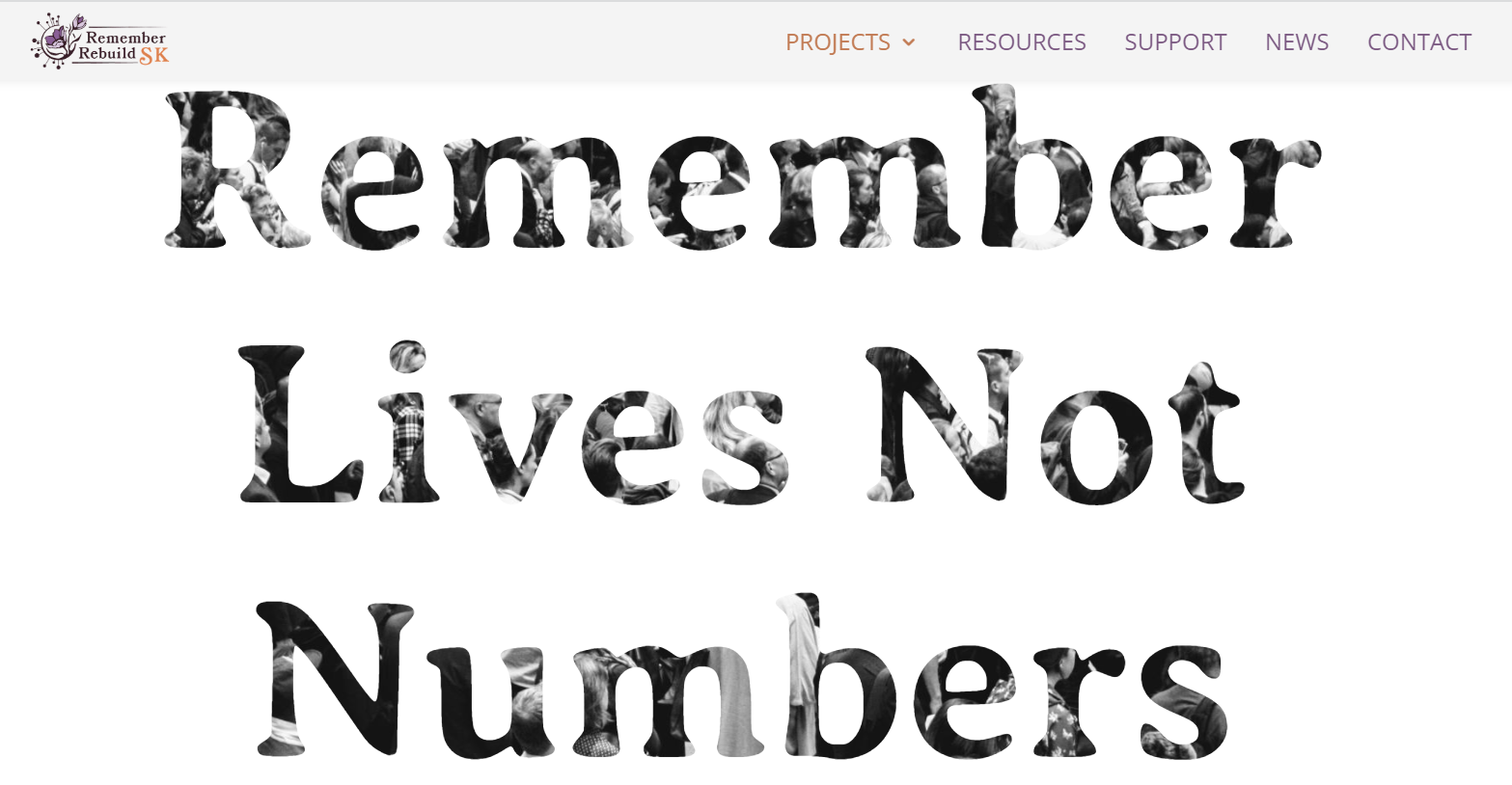
The COVID-19 Community Archive is a digital archive of life in Saskatchewan during the COVID-19 pandemic. It uses a multi-pronged collections approach: 1) materials related to everyday life, including: personal accounts, testimonies, diaries, social media; 2) materials related to the local public discourse, including: news releases, policy changes, school closures, essential services declarations; 3) science during COVID-19, including information about: laboratory shut downs, vaccine research, vaccine roll-outs, and research delays.
Canadian Institutes for Health Research, Covid Catalyst Grant, 2021-2023
in collaboration with Muhajarine Nazeem (PI); Macleod, Jane; Peoples, Akela; Adeyinka, Daniel A; Buhler, Sarah; Clifford, Jim; Dixon, James; Engler-Stringer, Rachel R; Findlay, Isobel M; Jeffery, Bonnie L; Kallio, Natalie; McCutcheon, Jessica; Mcintosh, Thomas A; Mela, Mansfield; Novik, Nuelle L; Novotna, Gabriela
During the first weeks days of the global pandemic, people in Saskatchewan watched COVID-19 make its way to the province. In March 2020, residents watched for daily updates on new infections, cases that required hospitalization-and, ultimately death rates-as we sheltered in place under lockdown, experiencing relatively low rates of infection. As of November 2021, during the Delta-driven fourth wave, Saskatchewan is experiencing the highest cases, hospitalizations, and deaths per capita, the health care system pushed beyond capacity. What explains the COVID-19 trajectory in this region? How will residents remember and recover from this global pandemic and apply its lessons to local circumstances, now and in the future? In particular, how did the pandemic-including policies and practices implemented throughout-impact the province's most vulnerable and how do we build better systems to cushion them in the future? Co-led by epidemiologist Nazeem Muhajarine and historian of medicine and T1 Canada Research Chair Erika Dyck, this interdisciplinary, bi-university, community-engaged team aims to document, preserve, understand, and communicate the wider impacts of the pandemic on social issues and public health, focusing on four interrelated areas: mental health, substance use, housing precarity, and food insecurity. Through a justice lens, we will examine how the pandemic has affected health disparities in equity-seeking groups and use that knowledge to recommend strategies to 'build back better,' in Saskatchewan and nationally. This research has immense potential to compel decision-makers to act on their own evidence and apply lessons from the pandemic in rebuilding our systems, programs and services, and community resiliency. Also, a longer-lasting product will be a digital, public archive sister project established to collect and preserve memories, reflections, insights from Saskatchewan residents during COVID-19.
SSHRC Insight Development Grant 2021-2023
This project explores Métis experience in Saskatchewan road allowance communities to the mid-twentieth century using oral histories, archival research, and HGIS research methodologies. It uses deep-mapping to investigate Métis displacement, dispossession, and relocation, including movement to government-sponsored social rehabilitation projects and urban centres. Deep-mapping is the digital collection and layering of different data types to map the narrative meanings embedded in specific places. It can represent multiple perspectives where the land acts as a mnemonic device, connecting individual stories, family photographs, memories, and material artifacts to specific landscapes and places expressed spatially and visually.
This research raises Métis voices and reveals a narrative of resilience, resistance and growing political consciousness as Métis adapted to new social, economic, and political environments. It uncovers a process of intentional community formation and dispersals across Saskatchewan, including how Métis used gaps and spaces in the colonial survey system to find land to live on, remain within familiar territory, and challenge intervention in their lives by provincial and municipal governments. Perhaps most importantly, this work recasts road allowance communities not as marginal or liminal places but as spaces where families, language, and cultural practices remain strong.
Social Science and Humanities Research Council, Insight Grant 2019-2025
Love and Litigation explores the intersections of marriage, nation state, the law, and social justice for queer couples and families. After the Court of Appeal ruled that prohibiting same sex couples from marrying was unconstitutional (2003), thousands of same-sex couples applied for marriage licenses and many were international couples.
Canada was the third country in the world to legalize same-sex marriage (2005) but unlike the Netherlands and Belgium, Canada did not restrict marriage licenses to its citizens - the policy extended to international couples. The legal legacy of these ruling extends beyond Canada's borders. Oral histories collected for this project illuminate the transnational and international importance of equal marriage.
Thousands of same sex couples from the United States, Great Britain, and beyond travelled to this surprisingly new “destination wedding location” and some of them, armed with their Canadian wedding certificates home, became both intentional and inadvertent activists in their home contexts. Much as been written in the American context about the political, religious and social challenges of same-sex marriage acquisition, and in the international context much has been written about specific national contexts. Little work is know about the Canadian dimension, its short-term and longer term international impact, and how such an unlikely national context played a role in international changes.
From the first attempt in 1972 by a Winnipeg same-sex couple to access legal marriage, to radical gay activism, the inclusion of sexuality into the Charter of Rights and Freedoms, and to the important - albeit neglected - legal case M v. H in 1999, this project analyzes the long winding road to same sex marriage in Canada, and its international implications.
Social Science and Humanities Research Council, Partnership Grant, 2019-2026

This project is part of a large seven-year partnership grant that brings together dozens of scholars and partner institutions. The partnership grant adopts an interdisciplinary and continent-wide perspective to explore waves of Francophone migration in North America over three centuries, as well as related cultural and linguistic transfers. Dr. Englebert’s contribution to the grant examines the role of Francophone migration in the development of the Illinois Country throughout the eighteenth and early nineteenth centuries. The Illinois Country was a colonial contact zone and borderland in the heart of North America that defied easy definition. Located in Illiniwek and Osage territory, the region experienced multiple francophone migrations. Processes of métissage, French cultural mobility, and ethnic classification complicate our understandings of a heterogeneous and complex population in a period of early colonial settlement. This work will use census data and marriage contracts to recreate webs of kinship and investigate their relationships to migration patterns. Dr. Englebert’s work seeks to understand how marriage, kinship, and migration shaped and reshaped the demographic composition and cultural character of Illinois Country, as well as the region’s ties to the rest of French North America and the Atlantic world.
Social Science and Humanities Research Council, Partnership Development Grant, 2021-2024

This Partnership Development Grant brings together historians, education specialists and students at the University of Saskatchewan with Heritage 5G (Birmingham and London), the Canadian Museum of History (Gatineau), the Western Development Museum (Saskatoon, Moose Jaw, North Battleford and Yorkton), the Borough of Newham's Heritage Service (London), the Lloyd's Register Foundation Heritage & Education Centre (London), and the Network in Canadian History & Environment. We are working together to create an augmented reality experience to explore the role of Canada in supplying essential raw materials to support London’s remarkable growth during the nineteenth century.
Holding a tablet computer, users in Newham or Saskatoon will explore a three-dimensional map of London and zoom in to explore the Surrey Commercial Docks in the 1830s, where ships unloaded timber, deals, planks and boards of different dimensions and species. The user will be tasked with discovering where the timber came from and the augmented reality will include portals to allow users to jump between different landscapes in the supply chain from the docks in London back to the timber coves in Quebec City, the rafts floating down the St Lawrence, the sawmills on the Gatineau River and the logging camps located hundreds of miles further up the Ottawa River.
The game will lead players to consider the importance of the Ottawa Valley forest for London's industrialization, during the 1830s and 1840s and the period of rapid growth spurred by the construction of the first railways, given the scarcity of forests and trees in the British Isles. The users will move on to explore the growth of shipping capacity, much of which was built in the Bay of Fundy, to connect London's factories and consumers to their global supplies of raw materials and food. Finally, the users will have the opportunity to see the connections between settler migration to Saskatchewan, railways, wheat farming and the construction of industrial-scale silos in the Port of Montreal and large industrial flour mills in Silvertown, on the eastern edge of Greater London. Learning this history will help users to consider how their lives rely on an unsustainable global network of supply chains to support their high levels of consumption.
Social Science and Humanities Research Council, Insight Grant, 2021-2025

The Shadows of Sovereignty project will map and quantify the growth of formal (extradition) and informal (state sponsored kidnapping) approaches to transnational justice from the 1840s until the 1930s. Set between the first effective extradition agreement between Britain and the United States (1842) and the moment the Canada-US border became a fully functioning institution (the 1930s), this project studies the growth of transnational justice during its formative years. In doing so, this project sheds light on how nations punished crime in lands they claimed no official jurisdiction over (e.g. US punishing crime on Canadian soil). It also illuminates how federal desires for practical solutions in both countries increased local power in transnational affairs.
Harry Frank Guggenheim Foundation, Distinguished Scholar Awards, 2021-2023

This project is a systematic study of the relationship between violence (vigilante and state-sponsored) and Indigenous mobility along the Canada-US border between 1865 and 1914 with three major aims. It aims to study how state-sponsored and vigilante violence shaped the transnational mobility of Indigenous communities in the decades that followed formal warfare. To do so it investigate whether changes to military infrastructure (military post conditions, supply routes, patrol patterns, etc) and deployment impacted day-to-day violence in regions that had recently experienced warfare. Finally, it investigates whether episodes of violence impacted patterns of incarceration in the decades that followed warfare.
Social Science and Humanities Research Council, Insight Grant, 2019-2023

In 1966 Professor of Surgery, Albert (Bert) Myburgh and his team at the University of the Witwatersrand (Wits) performed the first kidney transplant on the African Continent. Over the next 30 years this team became the most advanced and prolific kidney transplant unit in the country. Yet, these developments were -- like everything in South Africa at the time -- fundamentally shaped by the racist, oppressive and often violent apartheid system. Transplantation developed as an elite medical procedure, performed by a select group of white doctors on mostly white patients. It became a symbol of white supremacy in a country where the black majority were excluded from anything but the most basic of health care. My study provides a lens from which to write a racialized, micro history that illuminates the politics of medical discoveries and medical research radiating outwards from one of South Africa's most prestigious medical research universities and enables us to understand the influences that the broader social, political and economic context had on the research and practice of the transplant team.
Social Science and Humanities Research Council, Insight Grant, 2019-2023

Our project examines a fur trade society in the Great Lakes-St. Lawrence watershed by using Lapointe Post, situated on Lake Superior’s Madeline Island, as a research springboard. Founded in 1693, the important post gained even greater prominence in 1835 when the American Fur Company (AFC) moved its headquarters from Mackinac Island to Lapointe prompting the establishment of a Catholic mission by Father Frederic Baraga in the same year. The Lapointe post and mission were key economic and religious focal points for the western Great Lakes. Through a close reading of business, sacramental, and other records, we seek to understand the contours of a Catholic French Anishinaabeg community that manifested at Lapointe, but which was intrinsic to the broader Great Lakes-St. Lawrence watershed. Phase one of this project will reconstruct the kinscapes of families that came to the island to participate in key Catholic religious rites during the first decade of the mission’s presence on the island (1835-45). The sacramental records will complement data gleaned from surviving contemporaneous Great Lakes’ AFC records. Phase two of the project will use older fur trade, notarial, and ecclesiastical documents to conduct an upstream analysis, thereby linking the 1835-45 families to their forebears. This multi-generational approach will allow us to chart patterns of familial and economic activities within this fur trade world. Social Network Analysis will then be used to conduct relational longitudinal analyses of links between the population manifesting in the early Lapointe Catholic records and other communities throughout the Great Lakes-St. Lawrence watershed, thus providing insights into the genesis, contours, and life strategies of a poorly understood fur trade society between 1650 and 1850.
Social Science and Humanities Research Council, Insight Development Grant, 2019-2021
Drawing from archival research and approximately thirty oral-history interviews, Dr. Ashleigh Androsoff’s “A History of Harmony: Integration and Independence among Saskatchewan Doukhobors, 1899-2019” will explain how Saskatchewan’s Independent Doukhobors managed to preserve their distinctive ethnoreligious culture while adjusting to life in Canada. This community-engaged research will draw a connection between the Doukhobors’ unique practice of singing hymns in multi-part harmony and their application of a cultural “harmonization” strategy over a 120-year period, from their immigration in 1899 to present-day. Research findings will be made publicly available in a 60-minute documentary film, “We’ve Concluded Our Assembly,” produced with community partner Mr. Ryan Androsoff (Spirit Wrestler Productions, no close relation). In addition, this project will produce a museum exhibit developed in collaboration with Dr. Elizabeth Scott and the Western Development Museum (opening in June 2019). The exhibit will feature a unique 32-speaker immersive audio-visual “soundscape” that will allow visitors to experience Saskatchewan Doukhobors’ choral harmonization and a prayer meeting (moleniye) in person. Further details can be found at www.doukhoborlivingbook.ca.
Social Science and Humanities Research Council, Insight Grant, 2017-2022

This project addresses environmental change in Quebec between 1763 and 1918 as a product of the integration of the St. Lawrence Valley into international trade networks. During the long 19th century, the ports of Quebec and Montreal were active in supplying Great Britain with natural resources and food. The extraction and transformation of resources from the St. Lawrence Valley brings with it environmental and landscape consequences that contributed to the ecological footprint of British industrialization. To capture this footprint, we use the concept of ghost acres. In environmental history, ghost acres refer to the additional area a country needs to overcome the ecological limits of its immediate territory and to obtain the resources needed to supply its people and factories. The notion of ghost acres, as we interpret it, explores the transformations in the agro-forestry landscapes of the hinterland as well as changes in urban space and port facilities necessary for traffic and trade. To this end, we are rebuilding resource exchange networks – space-consuming raw materials and food – from the extraction site to their destination to identify the environmental transformations that result from their insertion into transatlantic economic circuits. Our research focuses on forest and agricultural products for which we analyze the intensity and spatiality of extraction activities as well as the port and industrial infrastructures set up in Quebec and Great Britain. The description of the landscape transformations of the trade of natural resources and food, extracted from the St. Lawrence valley and then exported to Great Britain, will lead us to understand the the colonial environmental repercussions of British urbanization. By thus exposing the ecological footprint of Britain’s industrialization, we will examine a neglected dimension of Canada’s integration into the British Empire. Further details can be found at http://niche-canada.org/commerce-imperial/.
Social Science and Humanities Research Grant, Insight Grant 2017
In collaboration with Matthew Savelli, David Herzberg, and Lucas P. Richert.
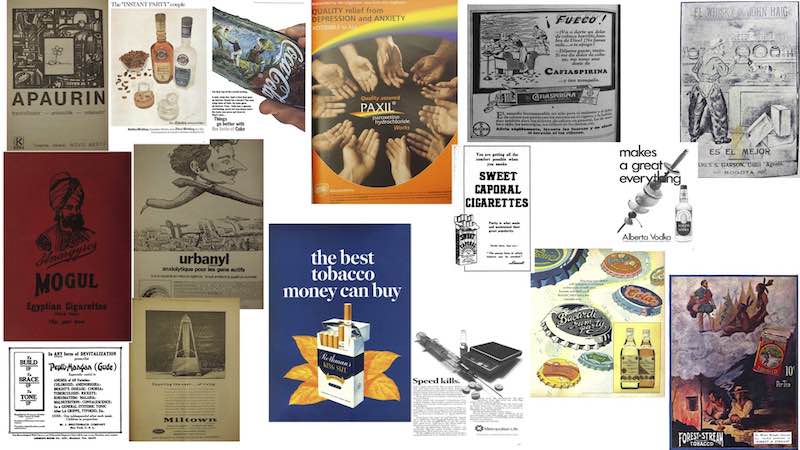
Pills, powders, liquids, and leaves – ranging from alcohol, caffeine, and tobacco to opioids, cannabis, and Valium – have been entrenched as essential components of people’s everyday routines for centuries. And so, in many ways, this is a study of human history and our unquenched curiosity to try, to know, to heal, to fear, and to sell psychoactive substances. The concurrent rise of the psy-ences, and the commodification of experience in pill form has hastened this connection between globalization and the history of pharmacy.
In 2018, Mat Savelli and I began a large-scale project on the global history of psychoactive drug advertising entitled Psychoactivity for Sale. Focusing on ads for caffeine products, alcohol, tobacco, and pharmaceuticals, we have collected over 5000 ads from five broad twentieth century jurisdictions (Canada, West Africa, Yugoslavia, Colombia, and India). Our research is designed to cut across cultural, ideological, and geographic contexts. We examine advertisements to analyse how the desire for particular states of consciousness, degrees of wellness, and reductions in distress have been inculcated and sold around the globe. So far, we are interested in knowing how producers of psychoactive products crafted advertisements in a manner that promoted self-regulation and independence. But taken together, these advertisements have also shown us that consuming psychoactive products itself was framed as a modern activity. In fact, a way to enact modernity - underpinned ad campaigns in contexts as diverse as interwar Yugoslavia, post-war Canada, and post-colonial Senegal. In making this case, we seek to contribute further to the literature which suggests that the history of psychoactivity must be understood simultaneously as a history of global capitalism.
Canadian Foundation for Innovation, 2017-2021.

The Canadian Peoples (TCP) is an integrated series of databases comprising 32 million records of Canadians enumerated in seven censuses 1861-1921. TCP makes useable for research the data describing personal, household and community characteristics at ten-year intervals from before Confederation to after the First World War. The principal users will reinterpret the experience of Canada's peoples in a formative era that set the patterns for subsequent generations. Our interdisciplinary collaboration of scholars from demography, geography, economics and history will undertake a series of linked studies leading to a new vision of the changing course of cultural heterogeneity and inequality. The knowledge generated by researchers, in turn, will inform policy-makers concerned with inequality, family, immigration, entrepreneurship, health, work, regional development, youth and aging, urbanization and other critical challenges. TCP will strengthen the training and retention of HQP who combine statistical expertise with social science and historical understandings in preparation for high-skilled employment in the digital economy. It will build new and existing collaborations and centres of research excellence. The ultimate beneficiaries of enriched understanding are the Canadian people who will acquire a deep understanding of the formative decades of Canada in long-term and comparative perspective.
SSHRC Insight Grant, 2017-2020

The Daughter of Aataentsic seeks to advance knowledge about the complex relationship between Wendat/Huron/Wyandot women, Feminism, and the colonial regimes of North America by finding out how Wendat women have confronted patriarchal policies and what strategies (if any) were successful. My current research project contributes to, and elaborates on, traditional Indigenous Feminist knowledge by exploring what strategies have been most successful in the historical struggles of seven Wendat women for cultural preservation during the years 1650-2006. Preliminary findings indicate that Wendat women have consistently turned to traditions of "motherwork" – work that is geared towards bettering their community circumstances with the ultimate goal of reinstating a pre-colonial “mother centered” value system. The case studies include women who conducted this type of work through their roles as teachers, missionaries, lawyers, environmentalists, intellectuals, diplomats, and nuns. This project is guided by a Wendat Women's Advisory Council, with representatives from across the Wendat Confederacy.
Social Science and Humanities Research Council, Knowledge Synthesis Grant, 2016-2017
Currently, no major research university in Canada has a systematic digital asset management system in place for Indigenous knowledge resources. To advance university efforts to build reconciliation, this project will develop, with community partners, recommendations towards the creation of a robust and genuinely Indigenous Digital Asset Management System. This Indigenous Digital Asset Management System will be a platform that synthesizes previously fragmented, and often inaccessible, Indigenous knowledge databases so that communities and researchers alike can access collections that are preserved and managed in ways that facilitate exciting new collaborations and knowledge mobilization.
Social Science and Humanities Research Council, Insight Grant, 2016-2021
The availability of Hollywood Hospital’s patient files provides an unprecedented opportunity to investigate the debate over drug use by shifting away from generalized analyses, or policy imperatives, and instead to concentrate on the plight of addicts themselves and produce a more comprehensive picture of how addiction has been historically treated and conceptualized. The patient files from Hollywood Hospital offer a closed set of experiences in a particular historical moment when a nascent harm reduction movement embraced LSD as a single-session treatment for alcoholism that welcomed a connection with spiritual, psychological, and social healing in an era before a formalized understanding of the social determinants of health. The full set of records, in combination with a renewed interest in psychedelic therapies makes this a timely investigation with significant potential to use historical analyses to inform contemporary practices and policy debates.

The Building Borders on Aboriginal Lands Project attempts to map and quantify Canadian and American attempts to expand their administrations and exert control at their peripheries through an ever-greater network of agencies and departments. By mapping both the presence of government officials and the concerns they expressed, this project is building a map of federal power and engagement between the 1860s and the 1930s that shifts as people were hired and fired, as posts were built and fell into disrepair, and as crises grew and faded.
 Within the Coast Salish world few things are as contested as tribal territoriality. In this project my Coast Salish partners and I seeks to help diffuse some of the contemporary tensions through an examination the way colonial actions have worked to undermine women’s historical consciousness and thereby foster a largely masculine discourse of tribal exclusivity relative to an increasingly eclipsed feminine consciousness relating to intertribal inclusivity. Our analysis includes researching the effects of colonialism on Coast Salish family life and will feature a spatial and temporal analysis of legendary Coast Salish narratives from the Stó:lō and Tla’amin communities for what they reveal about women’s perspectives on territorial space.
Within the Coast Salish world few things are as contested as tribal territoriality. In this project my Coast Salish partners and I seeks to help diffuse some of the contemporary tensions through an examination the way colonial actions have worked to undermine women’s historical consciousness and thereby foster a largely masculine discourse of tribal exclusivity relative to an increasingly eclipsed feminine consciousness relating to intertribal inclusivity. Our analysis includes researching the effects of colonialism on Coast Salish family life and will feature a spatial and temporal analysis of legendary Coast Salish narratives from the Stó:lō and Tla’amin communities for what they reveal about women’s perspectives on territorial space.
 There are thousands of tales out there that speak to important features of Canada’s history that have been lost or eclipsed. This collaborative project collects five regionally and thematically diverse and little-known stories about the Canadian past, transforms them into pieces of public art, and documents the process by way of a series of short films available in English and French. Carlson is playing the lead role in working with the Stó:lō community to bring back into the public consciousness the story of the more than two dozen Stó:lō children who were kidnapped by American miners and taken to California during the 1858 Fraser River gold rush. Among the best documented of these cases is that of a six year old Stó:lō boy who died three years after being abducted by a man named Crum. The boy now lies in an unmarked grave in his kidnapper’s family plot in Sacramento.
There are thousands of tales out there that speak to important features of Canada’s history that have been lost or eclipsed. This collaborative project collects five regionally and thematically diverse and little-known stories about the Canadian past, transforms them into pieces of public art, and documents the process by way of a series of short films available in English and French. Carlson is playing the lead role in working with the Stó:lō community to bring back into the public consciousness the story of the more than two dozen Stó:lō children who were kidnapped by American miners and taken to California during the 1858 Fraser River gold rush. Among the best documented of these cases is that of a six year old Stó:lō boy who died three years after being abducted by a man named Crum. The boy now lies in an unmarked grave in his kidnapper’s family plot in Sacramento.

The Powell River Historical Museum and Archives Association in partnership with the Tla'amin Nation and Prof Carlson from the University of Saskatchewan, are working together to develop a comprehensive digital map of place names used by the Tla'amin nation on their traditional territory on Canada’s Pacific Coast. The project is expected to be completed by March, 2018. The map will be searchable and include audio Tla'amin pronunciations.
Law Foundation of Saskatchewan, 2015-2017
To help protect Indigenous people’s “Gladue “ rights (as defined in the 1999 Supreme Court decision) staff and lawyers at Legal Aid Saskatchewan are seeking rigorously researched and easily accessible historical information pertaining to the colonial experiences of Indigenous people. This information is used to assist courts in taking into account First Nations and Metis people’s distinctive historical experiences as colonized people. In this project we are creating a large and complex spatial and temporal database that will better enable people to compose Gladue reports for pre-sentencing and bail hearings thereby assisting the courts in finding reasonable alternatives to incarceration for those convicted of a crime.

Birth control, abortion, and reproductive rights have a complicated and controversial history that has engaged policy makers, religious authorities, medical professionals, women, men and families in contests over family values. Historically, these debates have pitted feminists against non-feminists, or Catholics against non-Catholics, and socialists and conservatives have even made strange historical bedfellows. Some of these divisions have continued to frame the contemporary debates, but new alliances and divisions have also formed in the changing landscape and contests over family values, same-sex marriages, sex-selection technologies, cross-border adoptions, all of which contribute to a (re)defining of the modern family. This project adds critical historical context to these contemporary debates by producing a sophisticated investigation of reproductive politics in Canada since 1969.
SSHRC Insight Development Grant 2014-2016

This SSHRC Insight Development Grant funded project explores the environmental consequences of the expanding global commodity network that developed to supply London’s industrial economy during the second half of the nineteenth century. As Pomeranz argues, British industrial development was predicated on the resources contributed by distant “ghost acres” of land inside the British Empire and beyond it. This study intends to map metaphorically and concretely the “ghost acres” that fed the factories of London.

This study will trace the changes in this period's principal written source for practical magic: medieval ritual magic. This literature was taken up by an increasingly broad audience and thus provides a unique window into wider changes in the conception of magic. It allows us to trace, for example, the development of Protestant magic, of grotesque and self-consciously anti-social magic, and of incantation magic woven into the new scientific sensibilities of the age. It also allows us to see how these were brought about by a complex set of forces beginning in the late fifteenth century: the vernacularization and popularization of learned magic, the Protestant campaign against it, new trends in scientific thought, and the influence of the developing print media. It will argue that this period is marked less by a decline of magic than its transformation into forms that would assure its survival and development through the scientific revolution and enlightenment and into the present day. Sometime between 1450 and 1650, ritual magic was transformed from something requiring considerable explanation into something almost instantly understandable to modern sensibilities.

This interdisciplinary research project, funded by a SSHRC Partnership Grant, with matching contributions from partner universities and national science ministries in Austria and Spain, creates a formal partnership among 5 research groups in Europe, Latin America, and North America. For a decade or more these teams have explored the environmental history of agro-ecosystems in the past, using the perspective of socio-ecological metabolism to understand how farmers managed soil nutrients, landscape processes, and energy flows to sustain communities and produce food for themselves and society. Led by historians, the project also includes agronomists, soil scientists, landscape ecologists, economists, and demographers. Dr. Geoff Cunfer hosts the project at the University of Saskatchewan. The team includes over 30 faculty members plus dozens of graduate students and post-doctoral fellows at universities in Austria, Spain, Colombia, Cuba, the United States, and Canada.

